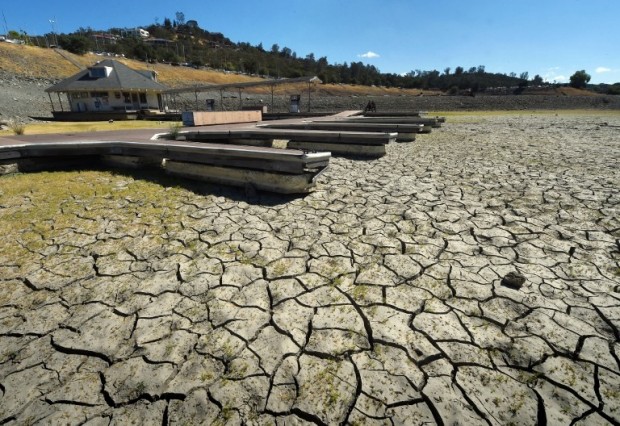
This file photo taken on September 17, 2015 shows boat docks sitting empty on dry land in Folsom Lake reservoir near Sacramento during the severe drought in California last year.
A report by the US National Oceanic and Atmospheric Administration (NOOA) on January 20, 2016 say that 2015 was the planet’s hottest year in modern times setting a troubling new milestone as the climate warms at an increasing pace. AFP FILE PHOTO
MIAMI—Blistering heat blanketed the Earth last year making 2015 by far the hottest year in modern times and raising new concerns about the accelerating pace of climate change.
Not only was 2015 the warmest worldwide since 1880, it shattered the previous record held in 2014 by the widest margin ever observed, said the report by the National Oceanic and Atmospheric Administration.
BACKSTORY: 2014 warmest year on record — NASA, NOAA
“During 2015, the average temperature across global land and ocean surfaces was 1.62 degrees Fahrenheit (0.90 Celsius) above the 20th century average,” said the NOAA report.
“This was the highest among all years in the 1880-2015 record.”
Compared to 2014, last year was 0.29 degrees Fahrenheit warmer, the “largest margin by which the annual global temperature record has been broken.”
The US space agency NASA, which monitors global climate using a fleet of satellites and weather stations, confirmed that last year broke records for heat in contemporary times.
NASA said that the temperature changes are largely driven by increased carbon dioxide and other human-made emissions into the atmosphere.
“Climate change is the challenge of our generation,” said NASA Administrator Charles Bolden.
“Today’s announcement not only underscores how critical NASA’s Earth observation program is, it is a key data point that should make policymakers stand up and take notice — now is the time to act on climate.”
Planet-wide heat
The latest finding adds to a steady rise in heat across land and sea surfaces that have seen records repeatedly broken over the years.
“Since 1997, which at the time was the warmest year on record, 16 of the subsequent 18 years have been warmer than that year,” said the NOAA report.
Last year alone, 10 months had record high temperatures for their respective months.
The heat was felt worldwide, with unprecedented warmth covering much of Central America and the northern half of South America.
Hot temperatures were observed in parts of northern, southern and eastern Europe as well as western Asia and a large section of east-central Siberia.
Regions of eastern and southern Africa experienced more scorching days than ever, as did large parts of the northeastern and equatorial Pacific boosted by the El Nino weather phenomenon.
But according to Tom Karl, director of NOAA National Centers for Environmental Information, new heat records would have been set even without El Nino, which leads to warmer waters in the equatorial Pacific.
“But El Nino pushed it way over the top,” Karl told reporters.
READ: El Niño closer to being strongest, hottest on record
More warming ahead
NOAA’s announcement came against a backdrop of the recently completed Paris climate talks, at which the goal of capping global warming at two degrees Celsius above pre-industrial levels was enshrined.
Many scientists say the planet is already about halfway to that milestone, with no sign of slowing down.
As a result, melting ice sheets and warming oceans will lead to rising seas in the coming years.
READ: Global warming turns oceans into ticking time bombs — study
Rain will become heavier and some storms more severe as the globe heats up, and cold snaps may become rarer.
“This trend will continue,” said Gavin Schmidt, director of NASA’s Goddard Institute for Space Studies.
Because of the strong El Niño influence at the beginning of this year, “2016 is expected to be an exceptionally warm year and perhaps even another record,” he told reporters.
According to Astrid Caldas, climate scientist at the Union of Concerned Scientists, the news of 2015’s record was no surprise, but the year-over-year jump merits attention.
“It’s significant that 2015 was hotter than the previous record by so much in both calculations because it points to a strong warming trend that’s been observed lately,” she said.
“A massive ramp-up of renewable — and low-carbon — energy will be essential to stay within two degrees Celsius of warming and avoid new records being set.”